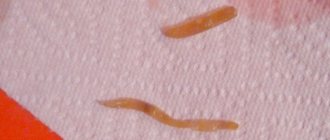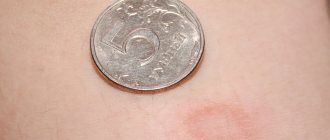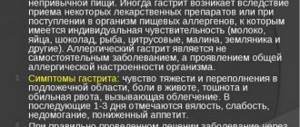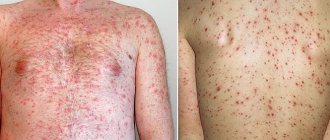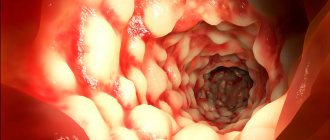Treatment
If, as a result of the diagnosis, one of the forms of toxocariasis was identified, in no case should you self-medicate by selecting an anthelmintic medicine. Despite the fact that these parasites are nematodes, they have their own differences from pinworms and roundworms, which are common among people, and, therefore, their own specific drug effects.
The treatment regimen should include a whole range of drugs, namely antihistamines and anthelmintics, anti-inflammatory drugs, and glucocorticosteroids.
The primary task is to destroy the pathogens of the disease, so the course begins with deworming.
| Drug name | Reception scheme |
| VERMOX | Adults: 100 mg 3 times a day. Children: 100 mg 2 times a day. Course 20–30 days. |
| ALBENDAZOLE, NEMOSOL | 10 mg/kg 10–20 days |
| DITRAZINE CITRATE | 2–6 mg/kg per day for 2–4 weeks. |
Treatment of toxocariasis in children and adults is most often carried out using the drug Vermox. This remedy is considered to be the most effective in the fight against these parasites. When using it, you can not only destroy them completely, but also successfully remove them from the body. Vermox, used as prescribed by the attending physician for toxocariasis, does not cause side effects and is well tolerated by many patients.
Ditrazine citrate is also one of the anthelmintics that is most effective against this type of nematode. Toxocara are sensitive to its active component, diethylcarbamazine. But unlike Vermox, this product is more toxic and less effective.
Nemozol for toxocariasis is also the drug of choice. It has a wide spectrum of action, so side effects are possible when using it. Since the course of treatment with Nemozol is long, if signs of intolerance to the drug appear, you should immediately consult a doctor.
All of the listed anthelmintics are contraindicated for pregnant and nursing mothers.
Treatment of toxocariasis in adults and children has its own characteristics. Eliminating this pathology is much more difficult than other infections. The causative agents of the disease, entering the body, not only parasitize it, but also provoke the development of allergic reactions. Therefore, a course of desensitizing therapy must be prescribed until the signs of trouble disappear.
| Drug name | Treatment regimen |
| CLARITIN | Adults: 1 tab. per day. Children: ½ tablet per day. |
| TAVEGIL | Adults: 1 tab. 3 times. Children: ½ tab. 2 times. |
| ZIRTEK | Adults and children over 6 years old: 1 tablet. Children 2–6 years old: ½ tab. Children from 0 to 2 years: 5 drops of solution per day. |
In addition to anthelmintics and antihistamines, patients are prescribed glucocorticosteroids - powerful anti-inflammatory drugs with immunosuppressive and antiallergic properties. The dosage and duration of taking GCS is determined by the attending physician.
Depending on the location of the damage to the internal organs, the patient may be recommended to consult with specialists:
- with an ophthalmologist for the ocular form of the disease;
- with a neurologist when toxocara penetrates the brain;
- with an infectious disease specialist or parasitologist to clarify the tactics of the selected therapy.
Features of treatment of ocular toxocariasis
As with other forms of the disease, in relation to helminths that have settled in the organs of vision, patients are prescribed the antiparasitic drugs listed above. Treatment is carried out under the supervision of an ophthalmologist.
Additionally, corticosteroids are prescribed, which show good results for this pathology, qualitatively relieving the inflammatory process caused by migrating Toxocara larvae. In the absence of the desired effect, subconjunctival and subten injections of Depo-Medrol (GCS) may be indicated.
If helminths in the organ cause retinal detachment, the choice remains with surgical or laser therapy.
Conclusions can be drawn about the effectiveness of treatment for any form of toxocariasis based on the following indicators:
- improving the patient's well-being;
- elimination of signs of the disease;
- positive dynamics in laboratory diagnostics.
Treatment methods
Treatment of toxocariasis in adults must be accompanied by correct and accurate diagnosis, which can only be done in a laboratory setting. In addition to the fact that a specialist must accurately confirm the presence of Toxocara, it is important to find out its type. This is necessary to select the optimal treatment method and reduce therapy time.
There are 3 options for diagnosing toxocariasis:
- Blood test (biochemical option). The presence of the parasite will be indicated by high levels of bilirubin and liver enzymes.
- Enzyme immunoassay of blood. Such an accurate method of studying biomaterial will help to find out not only the type of parasite, but also the size of the infection and the location of the lesion.
- General plasma examination. This method makes it possible to determine the presence or absence of parasites. In the first case, an increase in ESR is noted, and in the second, a decrease.
Before treating toxocariasis, the doctor may send the person for a number of other examinations. For example, you often need to undergo an ultrasound, tomography, or examination by an ophthalmologist.
Further treatment of toxocariasis in adults will be carried out according to the general treatment regimen:
- Destruction of parasitic infestation,
- Relieving a person of unpleasant symptoms of an illness,
- Treatment of emerging complications
- A set of actions aimed at healing and restoring the human body,
- Treatment of allergic reactions that may still bother the patient.
Due to the fact that it is impossible to guarantee a person’s cure for toxocariasis, he will often be prescribed repeated tests. This is done in order to confirm or refute the correctness of the chosen treatment method. If the patient's general condition does not improve and the symptoms do not completely disappear, the selected medications should be changed. If the number of larvae exceeds the permissible limit for medical treatment, doctors raise the question of surgical intervention.
Forms of toxocariasis
In terms of severity, this type of helminthiasis has the following forms:
- Latent – without visible manifestations or symptoms disturbing the patient;
- Erased - with minimal symptoms;
- Manifest – having a pronounced clinical picture.
Adults most often become ill with erased or latent forms of toxocariasis. Infection with helminths can have both an acute and chronic course. In the first case, exacerbations of the disease are replaced by periods of remission. Exacerbations are caused by the larvae migrating to new organs and tissues and causing a new series of clinical symptoms.
Forms of toxocariasis according to clinical manifestations:
- Visceral form;
- Neurological form;
- Eye shape;
- Skin form.
Visceral form
Diagnosed in 90% of cases of Toxocara infection. In the visceral form, helminth larvae infect the internal organs of a person. Depending on which system is invaded, symptoms of the disease appear. The larvae disperse using the bloodstream and settle where the blood flow is not too intense.
When they enter the digestive system, Toxocara settles in the liver, bile ducts, pancreas, and small intestine.
Disturbances in the outflow of bile and pancreatic enzymes into the duodenum, trauma to the intestinal walls are expressed by the following symptoms:
- Pain under the ribs in the projection of the liver and pancreas;
- Flatulence;
- Bitterness in the mouth;
- Loss of body weight;
- Alternating constipation and diarrhea;
- Heaviness on the right under the ribs;
- Nausea after eating;
- Abdominal pain;
- Anemia (weakness, tinnitus, pale skin) due to chronic damage to the wall of the small intestine and blood loss.
Symptoms of respiratory damage:
- Difficulty breathing and other catarrhal phenomena;
- Shortness of breath, asthmatic breathing;
- Dry cough;
- Frequent bronchitis, bronchopneumonia;
- An X-ray examination shows an enhanced pulmonary pattern and bronchopulmonary infiltration;
- Choking with blueness of the skin or nasolabial triangle (cyanosis).
An untreated visceral form of damage to the respiratory system can develop into bronchial asthma, pneumonia, and pulmonary edema.
When Toxocara enters the cardiovascular system, it leads to inflammation of the heart valve (endocarditis). Hemodynamic disturbances are complicated by heart failure.
Symptoms of heart damage from Toxocara:
- “cardiac” cough in a horizontal position (typical when the left half of the heart muscle is affected);
- Dyspnea;
- Blue discoloration of nails, fingers, nasolabial triangle;
- Swelling of the extremities and abdomen (typical when the left half of the heart muscle is affected).
Eye shape
This form of toxocariasis is extremely rare; it is characterized by damage to only one eye by a minimal number of larvae, usually one individual. Ophthalmoscopy can diagnose larval movement. If toxocariasis affects the optic nerve, the person will experience complete blindness in one eye.
Symptoms of the ocular form of toxocariasis:
- Redness of the conjunctiva;
- Swelling of the eyelids, hyperemia of the orbit;
- Bursting pain;
- Astigmatism;
- Protrusion of the eyeball.
Eye damage manifests itself in the following forms: uveitis, ocular granulomas, vitreous abscess, optic neuritis, keratitis, endophthalmitis. In adults, this form of toxocariasis is extremely rare; it is almost never accompanied by allergic reactions.
Cutaneous formWith this type of disease, the movement of larvae directly into the thickness of the skin is noticeable. Symptoms of the cutaneous form of toxocariasis:
|
Neurological form
It appears when the brain is damaged by larvae. In this form, the central nervous system, the membranes of the brain and its tissues are affected. The patient develops problems in the cognitive sphere and in the implementation of motor function.
Symptoms of the neurological form of toxocariasis:
- Convulsions, epileptic-type seizures;
- Impaired consciousness, fainting, coma;
- Vestibular disorders (shaky gait, balance problems);
- Hypersensitivity to stimuli such as bright lights, loud sounds, touches;
- Bursting headache;
- Nausea, vomiting;
- Muscle weakness up to complete immobility;
- The appearance of aggressiveness, affective behavior, inability to get out of a traumatic situation on your own.
Combined forms of toxocariasis are extremely rare. At the modern level, science counts isolated cases of such a combination.
Diagnosis confirmation
Doctors, if there is a high probability of infection with helminths and there are signs of their presence, recommend taking a series of tests for toxocariasis. Diagnosis of the disease is a difficult problem due to the lack of specific signs of the disease. Disturbances in the functioning of an organ cannot be interpreted unambiguously, since they can mean the presence of systemic pathologies of an infectious or organic nature, and parasitic infestations.
Before starting the diagnosis, a history is taken from the patient
A number of methods are used to obtain an accurate diagnosis:
- Anamnesis collection, during which the patient’s complaints are taken into account, the presence of objective data on the condition of internal organs and present dysfunctions.
- Laboratory diagnostics, during which antibodies to Toxocara are detected in the patient’s blood or DNA of parasites in the test material (punctate). Serological and enzyme immunoassays are considered the most informative in this regard. If the total antibodies exceed the permissible concentrations, the doctor can judge not only the presence of worms, but also their quantity.
- Instrumental diagnostics, during which the exact localization of worms in the internal organs is established. Among the most informative methods are MRI, ultrasound, and radiography. For toxocariasis of the eyes, ophthalmoscopy is used.
For the most effective treatment of toxocariasis and its consequences, the patient is prescribed auxiliary tests - standard blood tests (biochemistry, general clinical), general analysis of urine, blood and feces.
A blood test is performed to identify toxocara.
In some cases, materials are collected for laboratory testing during surgery.
Treatment of toxocariasis
When diagnosing toxocariasis, immediately begin treatment that will help get rid of helminth larvae. Consult a doctor, a specialist will help you choose the optimal treatment regimen.
Complete cleansing of the body is carried out in 3 stages:
- Preparatory – necessary for maximum cleansing of toxins secreted by the larvae. To do this, you should drink pumpkin or flaxseed oil for 5-7 days before each meal. You can use Enterosgel.
- Destruction of larvae - tablets are taken.
- Restorative - vitamin complexes are prescribed to help restore the normal functioning of organs and systems, and activate the regeneration of damaged tissues.
Flaxseed oil is great for cleansing the body.
The most effective tablets for toxocariasis:
- Nemozol is a medicine with the active substance Albendazole. Available in the form of tablets and suspensions. For toxocariasis, you need to drink 1 tablet or 20 ml of suspension with meals for 10 days.
Contraindications: eye diseases, low levels of leukocytes, pregnancy and the period before conception, hypersensitivity.
Side effects: nausea, bowel movements, sleep problems, confusion, headaches, kidney failure.
The cost of tablets is from 170 rubles, suspensions ─ from 200 rubles. Find out more about the drug Nemozol.
Nemozol – 1 tablet 400 mg
- Albendazole is a medicine with the active substance Albendazole. For treatment, 10 mg of the drug per 1 kg of patient weight is prescribed. This dose should be taken twice a day for 1-2 weeks.
- Vermox is a product containing the active ingredient Mebendazole, which destroys helminths. It is prescribed to children over 3 years of age, as well as to adults. The course of treatment lasts 1–4 weeks. During this period, you need to take 200–300 mg tablets daily, 2–3 times a day.
Vermox – 6 tablets 100 mg
Contraindications: liver failure, stomach ulcer, hypersensitivity, Crohn's disease, pregnancy, lactation.
Side effects: allergies, dizziness, nausea.
Cost per pack of 6 tablets ─ from 100 rubles. Find out more about Vermox.
- Mintezol is a medicine with the active substance Thiabendazole. The daily dose of the drug is calculated as follows: per 1 kg of the patient’s body weight, 25-50 mg of the drug, but not more than 6 g. It should be divided into 2-3 doses. Treatment lasts 5–10 days.
Additionally, anti-inflammatory and antiallergic drugs are prescribed during the treatment process.
It is possible to treat the ocular form of toxocariasis with Depo-Medrol injections. This is an anti-inflammatory medicine that is suitable for treating adults and children. The dose depends on age. In advanced cases, the larvae are removed surgically.
Important! Folk remedies will help alleviate the condition. They should be used in combination with medications.
Depo-Medrol for the treatment of ocular toxocariasis. Let's look at the most effective recipes:
Let's look at the most effective recipes:
- Grind the bark or young branches of the ash tree. 1 tbsp. Pour 200 ml of boiling water over a spoonful of the mixture and simmer for 10 minutes. Pour the broth into a jar and leave for 1 hour, wrapping the container in a towel. Drink the decoction in the morning and in the evening, 1 tbsp. spoon.
- 1 tbsp. Mix a spoonful of wormwood seeds with honey and drink three times a day.
- Pour 200 ml of boiling water 3 tbsp. spoons of tansy. Leave for an hour. Drink 1 tbsp. spoon 4 times per knock before meals.
The treatment regimen with folk remedies is to drink decoctions for a maximum of 1 week, after which you need to take a break for at least a week. This will prevent overloading the kidneys.
To remove Toxocara larvae, you must adhere to a diet throughout the entire period of treatment. The basis of the diet should be vegetables, grains, fruits, and herbs. It is advisable to eat a lot of pumpkin, apricots, carrots, peppers, spinach, garlic, cabbage, and basil. Dishes should be supplemented with hot and bitter spices. Helminths do not like mustard, ginger, cloves, pepper, turmeric, cumin, coriander. Seeds, nuts, and dairy products are also beneficial
It is important to drink 1.5–2 liters of water per day
When treating toxocariasis, it is necessary to exclude unhealthy foods from the diet, including various fast foods.
The effectiveness of treatment can be said if the clinical symptoms of the disease have disappeared, the level of eosinophils in the blood and the titer of antibodies to the parasite have decreased.
Prevention of toxocariasis
The most basic rules for preventing diseases caused by Toxocara larvae are:
- compliance with personal hygiene rules;
- if there are animals at home, he needs to be given anthelmintic medications once a year;
- Conduct an annual serological test for the presence of antibodies.
- To prevent helminthiasis, folk remedies are most often used. Once a year, over the course of a week, a course of herbal decoction from elecampane roots is drunk . For cooking you need 1 tbsp. dried elecampane pour 250 ml of boiling water and leave for 12 hours. Take 1 tbsp. 4 times a day.
Types of toxocariasis and their symptoms
The symptoms of toxocariasis in humans are so varied that doctors prefer not to make a diagnosis based solely on external signs. The symptoms of worm infestation depend on the form of the disease, the location of parasitism of the larvae, and the state of the body’s immunity. The main types of toxocariasis and their symptoms are reflected in the following table.
| A form of toxocariasis. | Places of invasion. | Signs. |
| Visceral. | Internal organs. | Ø abdominal syndrome (flatulence, abdominal pain, dysbacteriosis, diarrhea, vomiting); Ø toxic-infectious syndrome (low-grade fever 37.5-38 degrees, weakness, lethargy); Ø bronchopulmonary syndrome (cough, sometimes with white sputum, sore throat, difficulty breathing); Ø hepatic syndrome (the liver enlarges, pain occurs when pressing on it); Ø polylymphadenopathy syndrome (enlarged and painful lymph nodes). |
| Ophthalmic toxocariasis. | Muscles or internal components of the eye. | Purulent inflammation of the eye (endophthalmitis), severe visual impairment or partial blindness, inflammation in the iris or in the eyeball (iridocyclitis), pain in the orbit, swelling of the eyelids and overflow of blood into the tissues of the orbit. |
| Cutaneous. | Inner skin layers. | Rashes form on the skin (small papules with liquid inside), itching, burning, a feeling of something moving under the skin, and inflammation of the skin where the larvae are attached. |
| Neurological. | Toxocara penetrates the brain, causing inflammation, and neurological manifestations begin. | Absent-mindedness, decreased concentration, increased excitability, bursting headache, disruption of the vestibular apparatus, decreased mental abilities, hypersensitivity to bright light, touch, loud sounds, aggression. |
| Imaginal. | A rare form of the disease in which sexually mature helminths live in the intestines. | Dizziness, abdominal pain, nausea, loss of appetite. |
Symptoms differ in adults and children. For adults, the following symptoms are typical: fever, allergies, pancreatitis, cholecystitis, paralysis. Helminthic infestation in children is manifested by lethargy, inattention, chills and fever, a slight increase in temperature in the evening, problems with assimilation of information, and cough.
The form of toxocariasis is:
- manifest with clearly defined symptoms;
- erased when symptoms are mild;
- latent or hidden. It occurs without symptoms.
Toxocariasis in children under 12 years of age most often manifests itself in a manifest form; for adults it is characterized by a latent or erased form.
If less than 3 months have passed since the helminth infection, the disease is in the acute phase. If it is more, it means that its course is already chronic with periods of exacerbation and subsidence. During an exacerbation, the larvae become activated and begin to migrate throughout the body.
Forms of pathology
Infection of the gastrointestinal tract is typical for the visceral form of the disease. In this case, patients feel bitterness in the mouth and bloating. The stool becomes abnormal and the patient suddenly loses weight.
The ocular form is quite rare. The larva enters the orbit of the eye and disrupts the functioning of the visual organ. A patient with this form of the disease suffers from unbearable pain in the orbit. Infection with toxocariasis of the eye can lead to loss of vision. This form of the disease most often occurs in children.
When the larvae settle under the skin, the patient feels severe itching. The skin in the affected area turns red, the larvae can be felt moving under the cover, and traces of their movement are visible.
The most severe is the neurological form, when the larvae are localized in the brain tissue. With this form of toxocarasis, the patient feels severe headaches, suffers from nausea and vomiting. This disease can cause dysfunction of the vestibular system, seizures, mental disorders and even coma.
Toxocariasis - diagnosis
Toxic carcinoma is very difficult to diagnose. Regular stool samples taken at different times of the day will not give positive answers, because the larvae are often found in different parts of the body, and only lay eggs on the intestinal mucosa. A blood test helps determine the presence of this toxocara. An indicator in this case is an increase in protein and the number of eosinophils, acceleration of ESR. In addition to a general biochemical study, the diagnosis of toxocariasis includes:
- Taking a sputum sample from adults helps to establish the presence of a visceral form of the disease and investigate the degree of reproduction of Toxocara.
- Ultrasound of the peritoneal cavity will detect the presence of toxocara in the pancreas, heart, bronchi, and spleen.
- Chest X-ray - will be effective for pulmonary toxocariasis.
- CT scan with MRI will determine the presence of parasites in the brain and spinal cord.
- Ophthalmoscopy - will be effective for ocular toxocariasis.
Blood test for toxocariasis
The most informative method for diagnosing invasion in adults is testing the patient’s venous blood for antibodies to Toxocara. The essence of the method is that upon contact with the helminths toxico canis or catis, the immune system immediately responds and begins to produce special anti-igg or igm bodies. In a healthy person, the norm for a diagnostic titer is considered to be a study where the total coefficient does not exceed the ratio of 1:100. If the decoding of antigens goes beyond the scope, there is a high probability of developing toxocariasis.
Analysis for toxocariasis may not be informative in the following cases:
- when Toxocara affects the eyeball or retina;
- if diagnosed too early, when the body has not yet developed a sufficient amount of antibodies;
- the adult has already undergone treatment for toxocariasis in the past.
Prevention
The best way to treat toxocariasis is to prevent its development. To do this, you must adhere to certain preventive measures:
- carefully observe the rules of personal hygiene;
- limit or completely avoid contact with stray animals;
- When carrying out garden work, use gloves that will protect the skin from possible damage by Toxocara larvae.
Paying attention to your own health and hygiene will help you avoid many unpleasant diseases associated with parasites. If infection does occur, you must immediately seek medical help.
Home page
Life cycle
Cats and dogs can become infected with Toxocara by eating eggs or by passing the larvae from a mother to her offspring. Transmission can also occur when larvae enter from infected accidental hosts - earthworms, cockroaches, rodents, rabbits, chickens, sheep.
Further development is similar to the human roundworm. Inside the intestine, the eggs hatch into larvae in the second stage of development. Although there is controversy over the appearance of a second or third larval form. They enter the bloodstream and migrate to the lungs, where they are coughed out and re-swallowed. They then mature into adults within the small intestine of a cat or dog.
Mating and laying also take place there. The eggs are passed in the feces and become infective only after several weeks outside the host. During this period, the development of the first to second (and possibly third) stage of the larva inside the egg occurs, i.e. maturation.
In most adult dogs and cats, the full life cycle does not occur, but the second stage larvae are encapsulated after a period of migration by the body. Only pregnant or lactating cats and dogs have active larvae. The complete life cycle usually occurs only within such females and their offspring.
A second form of larvae also hatches in the small intestine of an accidental host, such as a human, after ingesting infective eggs. They then migrate through organs and tissues - most often to the lungs, liver, eyes and brain. Since the larvae cannot mature in the bodies of accidental hosts, after their migration they get stuck in the blood vessels and penetrate into neighboring tissues, where they become encapsulated.
It is possible to defeat parasites!
— Reliable and safe removal of parasites in 21 days!
- The composition includes only natural ingredients;
- Does not cause side effects;
- Absolutely safe;
- Protects the liver, heart, lungs, stomach, skin from parasites;
- Removes waste products of parasites from the body.
- Effectively destroys most types of helminths in 21 days.
There is now a preferential program for free packaging. Read .
Hello, readers of the site about parasites Noparasites.ru. My name is Alexander Lignum. I am the author of this site. I am 23 years old, I am a 5th year student at the Kemerovo State Medical Institute. Specialization "Parasitologist". More about the author>>
Search for cures for parasites
Other tests
Symptoms of toxocariasis
Toxocariasis in adults, as well as in children, can have its own characteristic clinical picture, which completely depends on the form of the pathology. That is, it depends on where exactly the worm was localized (in which internal organ or system). In this case, the intensity of the symptoms will depend entirely on the degree of infection (the number of parasites in the body).
It is noteworthy that human roundworms and animal Toxocara are similar in appearance. However, the human body is not a biological storage chamber and habitat for Toxocara. Rather, nematodes enter the human body by mistake.
Visceral form of toxocariasis
This form of toxocariasis, the symptoms and treatment of which must be no less thorough, is formed under the influence of a large number of parasite larvae entering the human body. At the same time, children suffer from the visceral form of infection more often. But the pathology is also observed in adults, although with fewer cases. The presence of Toxocara worms in the body with visceral toxocariasis is indicated by the following signs and symptoms:
- Feverish conditions with relapses;
- Enlargement of the liver by 0.5 times;
- The appearance of a dry cough of the bronchitis type. In this case, the patient suffers from cough more often at night than during the day;
- The appearance of asthmatic shortness of breath;
- Nausea and vomiting;
- Flatulence, bloating and diarrhea;
- Enlarged lymph nodes.
Skin form of parasitic infection
In this case, the presence of toxocara in a person will be indicated by various skin reactions of the allergic type. Moreover, they will be formed during the migration of worm larvae. In particular, the patient may experience the following skin manifestations:
- Eczema;
- Edema;
- Hives;
- Redness in the form of local spots;
- Itching.
What is Toxocara - description of the helminth
Toxocaras are round worms that look very similar to roundworms, but are more modest in size. Thus, females grow to a maximum of 18 cm, and the length of males does not exceed 10 cm. Externally, the worm looks like a slightly yellowish thin thread up to 1 mm thick. Worms of both sexes differ slightly in appearance:
- In females, there are three processes in the head area. Males also have them, but next to them there is also a sucker.
- The back of female Toxocara is straight and cone-shaped, while in males it is curved.
- There are 26 pairs of papillae on the “tail” of male helminths, while females do not have them.
Type and structure of Toxocara
The main carrier of the worm is the dog, and it can be found in the small intestine of the animal. It is here that the reproduction of helminth larvae occurs. Studies have shown that the productivity of one worm is at least 200,000 eggs per day.
In some forms of toxocariasis, it can be seen with the naked eye, since in children and adults the worms cannot develop in the intestines, and often get into the eyeballs, eyelid tissues and even under the skin.
Diagnosis and analysis for toxocariasis
Diagnosis of toxocariasis presents certain difficulties due to the absence of pathognomonic symptoms in the disease. Detection of migrating larvae is very difficult.
At the initial stages of diagnosis, a detailed collection of life history is necessary. All factors that increase the likelihood of a diagnosis of toxocariasis are taken into account.
It is necessary to clarify the presence of animals (cats and dogs) in a person’s environment; the type of professional activity (contact with animals, land) is taken into account; age is of no small importance (children 1–4 years old have an increased risk of infection). It is necessary to inquire about a person’s food preferences, how meat is processed when preparing it for food, whether meat is eaten with blood
Routine blood tests play an important role in making a diagnosis. A general blood test reveals eosinophilia, which indicates allergization of the body; possibly a moderate decrease in hemoglobin levels (anemia); leukocytosis to high numbers; accelerated ESR. The severity of eosinophilia and leukocytosis largely depends on the level of infection of the human body with Toxocara larvae.
Analysis of feces for the detection of worm eggs does not have practical significance as with other helminthiases because In the human body, Toxocara larvae do not reach sexual maturity, and therefore are not capable of reproduction by laying eggs.
If pneumonia is suspected, a chest x-ray is usually done. With toxocariasis in the image, the radiologist sees darkening characteristic of pneumonia, plus “volatile” infiltrates that change their location over time. There is an increase in pulmonary pattern.
For recurrent abdominal pain, an ultrasound of the abdominal organs is performed, which shows foci of low density in the liver, small calcifications, changes in the structure of the pancreatic parenchyma, and hepatosplenomegaly.
Of primary importance for making a diagnosis of toxocariasis is an immunological blood test for toxocariasis, because Antibodies to Toxocara begin to develop during the migration of larvae.
Blood is tested for toxocariasis using ELISA. The immunoglobulin G titer is calculated. Immunoglobulin G accumulates in the blood within 6-8 weeks from the onset of invasion. Their precursors, immunoglobulins M, are usually not determined because begin to be produced during the migration of larvae and indicate a fresh invasion of the parasite. By the time the clinical picture appears, they are no longer detectable and are replaced by the production of immunoglobulin G.
Significant titers of toxocariasis are 1:800. These figures not only confirm the diagnosis of toxocariasis, but also indicate a significant infestation of larvae in the human body.
Lower titers of toxocariasis 1:200; 1:400 indicates a weak infestation of larvae and the possibility of toxocariasis or toxocariasis of the eyes and/or central nervous system, because in these forms, specific antibodies are either not detected or are detected in low titers.
A toxocariasis titer of 1:100 indicates the absence of invasion and requires repeated testing. Such a titer in the presence of invasion is possible in the early stages of infection, when the immune system has not yet developed protective antibodies. An increase in AT titer during repeated testing confirms the diagnosis of toxocariasis.
The AT titer can also be positive in people who have previously had toxocariasis. In this case, the AT titer does not increase.
Blood for toxocariasis is taken from a vein in the morning on an empty stomach. It is advisable to refrain from smoking 30 minutes before blood sampling.
Pathogenesis of toxocariasis
Toxocariasis begins to develop in adults after the larvae penetrate the digestive tract. Then, through large and small vessels, the worms spread throughout the body. Already at this moment, antibodies to Toxocara antigens can be detected in the patient’s blood. Many people don't understand what this really means. Experts explain that this is how parasites try to weaken the body’s defenses and survive in a new environment. They secrete specific compounds in an attempt to protect themselves from immune attacks; the igg antibodies they produce can “attack” the cells of the body itself. Already at this stage, the first symptoms of toxocariasis appear, which are most often expressed by fever and itchy skin.
The habitat of Toxocara can be the lungs
To develop, Toxocara larvae stop in various tissues of the human body. Most often, they choose as their habitat:
- parenchyma of the pancreas and liver;
- lungs;
- muscle fibers (skeletal and myocardium);
- brain;
- eyeballs (often observed in children).
If the body is in good condition, toxocara does not provoke unpleasant symptoms. They are covered with a thin film shell and are in a state of a kind of suspended animation. But if general immunity decreases for some reason, the parasites begin to actively feed, releasing a huge amount of toxins.
Toxocara can parasitize the human brain
At this time, antibodies to toxocara are observed in the patient’s blood in increased quantities, and the symptoms represent intense intoxication of the body.
Toxocariasis is especially dangerous in children, but even if it is present in adults, changes in many body functions are observed. In general, the risk of pathologies developing as a result of invasion depends on the location of the parasites.
Toxocariasis - description of the disease
Toxocariasis is caused by nematode roundworms from the Toxocara class, which primarily affect canine mammals: wolves, foxes, raccoons, dogs, arctic foxes. The length of a male Toxocara is from 4 to 10 cm, in females it is 7–8 cm. In the body of their main host, they rapidly multiply, releasing millions of eggs into the environment. The female Toxocara lays up to 200 thousand eggs per day, which are released into the environment, spreading and spreading everywhere. Each egg contains a living larva, which is protected by a multi-layered durable shell. Thanks to the protective shell, Toxocara eggs can maintain their viability for a long time, awaiting a potential host and favorable conditions for their development.
There are two types of Toxocara:
- Toxocara canis, parasitic in the dog's body;
- Toxocara cati, a parasite in the cat's intestines.
Animals both at home and in the wild become infected by eating small rodents, insects, food in garbage containers, and by licking objects on the ground. It is known that more than 40% of the soil is contaminated with Toxocara eggs. In many dogs, toxocariasis is a congenital disease, since puppies are infected through the placenta already in the womb or through milk during feeding. Subsequently, toxocara are localized in puppies in the intestines and are released into the environment with feces.
Routes of infection
The development cycle of Toxocara involves two hosts: one intermediate and one main. The source of infection is sick animals, most often dogs. Through dirty hands, after contact with an animal, Toxocara eggs are ingested by humans. Once in the small intestine, the larvae are released from the eggs and absorbed through the intestinal wall into the bloodstream. With the blood flow, they migrate throughout the body, causing severe allergization of the body at this time. The spectrum of their migration is quite wide; together with the bloodstream, they enter the liver, lungs, brain, kidneys, eyeball, bile ducts, and pancreas. They can settle in organs and tissues, become covered with a capsule, and in this state remain viable for 10 years. Then, for some reason, the parasite larvae become active, continuing their migration to other organs and systems. This movement of larvae does not leave its mark on the body. At the site of their invasion, traces remain in the form of necrosis, inflammatory processes and injured tissue.
A person is not a source of Toxocara infection, since the development of adult individuals does not occur in his body and the eggs of this helminth are not released. The source of infection is dogs. They are the ones who excrete Toxocara eggs in their feces, since the full development cycle of these parasites occurs in their bodies.
Do not confuse canine ascariasis and human ascariasis, especially, do not confuse these two diseases with toxocariasis, the causative agent of which is the parasitic worm Toxocara canis.
Dogs are not always the source of infection. You can also become infected through food, after eating poorly washed vegetables, herbs, berries and fruits, through water and as a result of simple non-compliance with personal hygiene rules.
There are factors that contribute to infection with this helminthiasis:
- contact with contaminated soil while working in the garden, playing with a child in the sandbox;
- eating poorly washed vegetables, herbs, berries and fruits;
- consumption of poor quality drinking water;
- contact with animal fur;
- cases of pica (the desire to eat inedible objects) in this case, eating clay, earth, chalk, sand;
- failure to comply with personal hygiene rules (dirty hands);
- work activity, people whose work activity involves cleaning streets, working with dogs, land, hunting, etc. become infected;
- contact with the excrement of cockroaches that eat Toxocara eggs;
- animals perform the act of defecation on the street; if you step on the feces, you can bring them into the house with your shoes.
Statistics show a high degree of infection among socially vulnerable people who have poor living conditions and a lack of public amenities.
Toxocars - what is it?
Toxocara are worms belonging to the order of roundworms. Sexually mature individuals have a fairly long, reddish body, reaching 18–20 cm in length and 2–3 mm in width. Outwardly, they look like a human roundworm. To verify this, just look at the photo.
Toxocaras can reach 20 cm in length
In this form, Toxocara parasitizes in the intestines of dogs, wolves, foxes - the species Toxocara canis, as well as cats - Toxocara cat. Only dog worms are dangerous to people.
To understand how animal parasites end up in the human body, as well as what harm they cause, you should consider the development cycle of these helminths:
- The pathogen enters the human body by ingesting Toxocara eggs. Invasive (contagious) eggs first enter the intestines. It is there that they develop into larvae.
- The larvae penetrate the circulatory system, due to which they spread throughout the human body. Most often they affect the heart, eyes, liver, muscles, and brain. Helminths stop developing, but cause great harm to health.
The infection sequence is shown in the diagram:
When the larvae find themselves in the bodies of animals, after damaging the lungs and other internal organs, they penetrate the intestines, where they quickly reach sexual maturity. Adult females secrete up to 200 thousand eggs daily. Together with feces, they are excreted from the body and infect animals as well as people. It is important to note that they, like roundworm eggs, need to go through the stage of maturation in the soil. It lasts 1–4 weeks, depending on the microclimate.
There is also an auxiliary life cycle for the development of helminths. It is characteristic of animals. The bottom line is that the larvae penetrate the fetus through the placenta and develop there. As a result, puppies are born already infected with worms.
Infection with Toxocara in humans occurs through the fecal-oral route. Most often this happens in the following situations:
- when drinking contaminated water;
- when eating poorly washed vegetables and fruits to which worm eggs are attached;
- during contact with animals;
- when ignoring the rules of personal hygiene;
- as a result of ingestion of dust, pet hair, on the surface of which there are infective eggs;
- A pregnant woman can infect her fetus with Toxocara larvae.
This disease is not transmitted from person to person.
This is what Toxocara look like
How active Toxocara will be in a person depends on the state of his immune system. Under the most favorable circumstances, the larvae become encapsulated and then die. Then recovery comes. They can also be encapsulated, but retain the ability to live.
In this case, when immunity decreases as a result of the influence of the external environment, stress, or taking a number of medications, they are activated and begin to destroy the affected organs and actively move throughout the body.
More on the topic: How to remove a tapeworm from the human body?
Toxocariasis can have very serious consequences - blindness, partial necrosis of internal organs, development of tumors, death if the larvae penetrate the myocardium. The specific consequences depend on the form of the disease and the number of helminths. Worm larvae live in the body for several years.
Toxocariasis is dangerous due to possible blindness and even death



